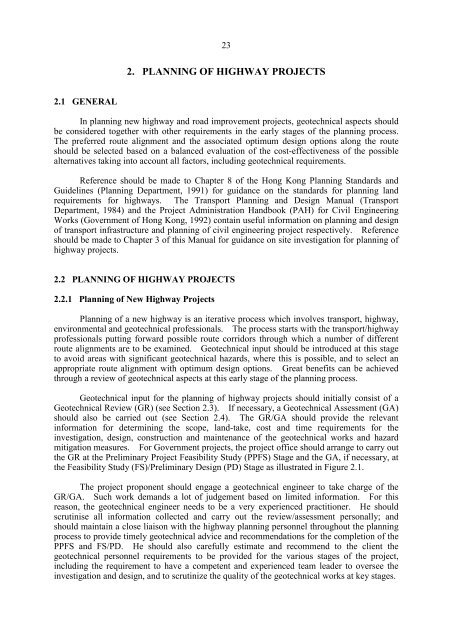Highway Slope Manual
Highway Slope Manual
Highway Slope Manual
Create successful ePaper yourself
Turn your PDF publications into a flip-book with our unique Google optimized e-Paper software.
23<br />
2. PLANNING OF HIGHWAY PROJECTS<br />
2.1 GENERAL<br />
In planning new highway and road improvement projects, geotechnical aspects should<br />
be considered together with other requirements in the early stages of the planning process.<br />
The preferred route alignment and the associated optimum design options along the route<br />
should be selected based on a balanced evaluation of the cost-effectiveness of the possible<br />
alternatives taking into account all factors, including geotechnical requirements.<br />
Reference should be made to Chapter 8 of the Hong Kong Planning Standards and<br />
Guidelines (Planning Department, 1991) for guidance on the standards for planning land<br />
requirements for highways. The Transport Planning and Design <strong>Manual</strong> (Transport<br />
Department, 1984) and the Project Administration Handbook (PAH) for Civil Engineering<br />
Works (Government of Hong Kong, 1992) contain useful information on planning and design<br />
of transport infrastructure and planning of civil engineering project respectively. Reference<br />
should be made to Chapter 3 of this <strong>Manual</strong> for guidance on site investigation for planning of<br />
highway projects.<br />
2.2 PLANNING OF HIGHWAY PROJECTS<br />
2.2.1 Planning of New <strong>Highway</strong> Projects<br />
Planning of a new highway is an iterative process which involves transport, highway,<br />
environmental and geotechnical professionals. The process starts with the transport/highway<br />
professionals putting forward possible route corridors through which a number of different<br />
route alignments are to be examined. Geotechnical input should be introduced at this stage<br />
to avoid areas with significant geotechnical hazards, where this is possible, and to select an<br />
appropriate route alignment with optimum design options. Great benefits can be achieved<br />
through a review of geotechnical aspects at this early stage of the planning process.<br />
Geotechnical input for the planning of highway projects should initially consist of a<br />
Geotechnical Review (GR) (see Section 2.3). If necessary, a Geotechnical Assessment (GA)<br />
should also be carried out (see Section 2.4). The GR/GA should provide the relevant<br />
information for determining the scope, land-take, cost and time requirements for the<br />
investigation, design, construction and maintenance of the geotechnical works and hazard<br />
mitigation measures. For Government projects, the project office should arrange to ca rry out<br />
the GR at the Preliminary Project Feasibility Study (PPFS) Stage and the GA, if necessary, at<br />
the Feasibility Study (FS)/Preliminary Design (PD) Stage as illustrated in Figure 2.1.<br />
The project proponent should engage a geotechnical engineer to take charge of the<br />
GR/GA. Such work demands a lot of judgement based on limited information. For this<br />
reason, the geotechnical engineer needs to be a very experienced practitioner. He should<br />
scrutinise all information collected and carry out the review/assessment personally; and<br />
should maintain a close liaison with the highway planning personnel throughout the planning<br />
process to provide timely geotechnical advice and recommendations for the completion of the<br />
PPFS and FS/PD. He should also carefully estimate and recommend to the client the<br />
geotechnical personnel requirements to be provided for the various stages of the project,<br />
including the requirement to have a competent and experienced team leader to oversee the<br />
investigation and design, and to scrutinize the quality of the geotechnical works at key stages.

















